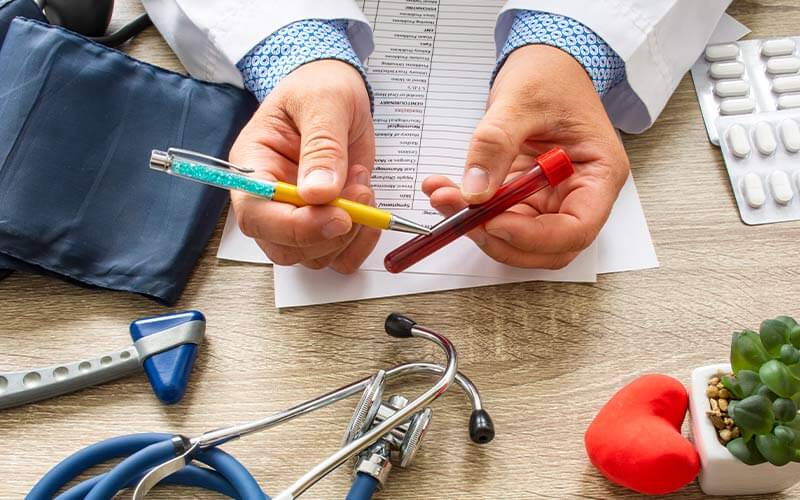The anemia diagnosis is a critical public health issue, and, according to the WHO, this condition affects 29.9% of women aged 15-49 years worldwide (1). It can also lead to physical problems and impair the intellectual and working capacity of those affected (1). Fortunately, some types of anemia are preventable. Here we will explain what anemia is, what are the symptoms that lead you to suspect that it may be present, how it is diagnosed, and what you can do to prevent it.

What is anemia and why does it occur?
Anemia is a medical term that describes the low amount of red blood cells, or hemoglobin in the body. Besides, red blood cells are cells found in the blood. They contain hemoglobin, which is a protein that carries oxygen to the lungs throughout the body (2).
The amount of hemoglobin varies according to gender (men and women) and age. For instance, adult women should have between 120-160 grams of hemoglobin per liter of blood (2). If a blood sample yields a value below 120 grams per liter, an anemia diagnosis is made (3).
This condition is caused by 3 different mechanisms (4,5):
- Bleeding: this can occur in acute hemorrhage such as that which occurs after injury. It can also occur because of chronic blood loss, such as a gastric ulcer or uterine irregular bleeding due to myomatosis.
- Increased destruction of red blood cells: these cells can rupture inside the arteries due to various diseases, or because they are structurally defective.
- Low red blood cell production: the problem may be in the bone marrow that does not produce enough cells or in any of the stages of production. For example, when there are nutritional deficiencies of iron or vitamin B12, it is not possible to form healthy red blood cells, even if the marrow is working properly.
Anemia diagnosis: the most common types
- As part of the diagnostic process, your doctor will need to identify the type of anemia you have. These are the most common types (6):
- Due to iron deficiency.
- Due to vitamin B12 or folic acid deficiency.
- anemia due to chronic illness.
- Haemolytic anemia.
- Aplastic anemia.
- Associated with pregnancy.
While some risk factors for the development of this condition are (6):
- Being over 65 years of age.
- Being an adolescent, pregnant or breastfeeding, as the need for iron increases at this moment in life.
- Having a brown discharge, heavy menstruation, or an irregular menstrual cycle where some months there is no bleeding. In other months there is an excessive bleeding and sometimes absence of menstruation.
- Family history of anemia.
- Insufficient intake of iron, vitamin B12 and folic acid.
- Intestinal disorders that prevent proper absorption of nutrients.
- Diseases that affect the structure of red blood cells. In these cases, as thalassemia.
- Suffering from chronic kidney disease or cancer.
Signs, symptoms and Anemia diagnosis
This condition can manifest itself in multiple ways, depending on the cause. However, the most common signs and symptoms that guide the anemia diagnosis are (2):
- Fatigue and extreme tiredness.
- Dizziness and lightheadedness.
- Pallor of the skin.
- Fragile and deformed nails.
- Hair loss.
- Trouble concentrating.
- Shortness of breath.
- Cravings for non-food substances (pica).
The anemia diagnosis is made by a blood test that measures both the number of red blood cells and the amount of haemoglobin. In some cases, additional tests may be required to determine the underlying cause of the anemia (3).
In addition, identifying the cause is vital to establish accurate and timely treatment. When left untreated, anemia can increase the risk of catching colds and flu. It can also cause problems with the functioning of the heart, lungs, and nervous system. In severe cases, heart failure and even death are possible (7,8).
Treatment and prevention
Treatment varies according to the cause identified during the anemia diagnosis. Iron supplementation or more complex procedures to treat underlying diseases may be necessary. While prevention includes (2,6):
- Eating a varied diet. This should include foods with iron (red meat and legumes), vitamin B12 (meats and dairy), folic acid (dark green leafy vegetables), and vitamin C (citrus fruits and broccoli).
- Seek help from a nutrition professional if you follow a vegan or vegetarian diet.
- Monitor your health during periods of life when there is a higher risk of anemia, such as adolescence, pregnancy, or menopause.
Finally, the anemia diagnosis is crucial to establish an appropriate treatment according to the cause and prevent serious complications. We recommend that you see your doctor if you have any symptoms suggestive of anemia.
Bibliographical references
1. World Health Organization. Anaemia in women and children
children
2. NHS. Anaemia in adults: the basics.
Nov 04> Available from:
https://www.uhcw.nhs.uk/download/clientfiles/files/Anaemia%20in%20Adults
%20(1915)%20(1).pdf
3. Badireddy M y Baradhi K. Chronic anemia.
https://www.ncbi.nlm.nih.gov/books/NBK534803/
4. Turner J., Parsi M., Badireddy M. Anemia.
https://www.ncbi.nlm.nih.gov/books/NBK499994/#:~:text=Anemia
5. Braunstein E. Overview of anemia.
disorders/anemia/overview-of-anemia
6. Mayo Clinic. Anemia.
Available from: https://www.mayoclinic.org/diseases-conditions/anemia/symptoms-causes/syc-20351360
7. NHS. Iron deficiency anaemia.
04.> Available from https://www.nhs.uk/conditions/iron-deficiency-anaemia/
8. NHS. Vitamin B12 or folate deficiency anaemia.
You May Also Like

JOIN US AND GET 10%OFF
Sign up to our newsletter to access free resources, advice and support.







